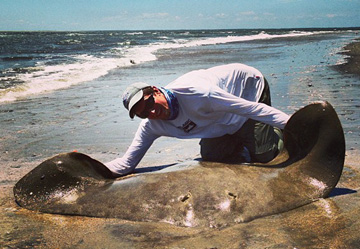
By Andrew Kumjian
Here are some great tips for surf fishing along the Outer Banks of North Carolina, the beach at Sandbridge or on Virginia’s Eastern Shore.
Recently there have been a lot of members of the forum asking a lot of questions about all aspects of surf fishing. While I do not mind at all answering questions, especially about something I love to do, many of the questions are generally about the same things. So I have decided to do a write up about surf fishing, covering as many topics as I can think of. Please keep in mind that I am no expert; I just spend 90% of my time fishing, standing on the beach. Everyone is going to have different opinions about rigs, rods, reels, baits, bait placement, etc. The advice and pointers I give are what I have found works best for me. As always, if you have any questions please do not hesitate to contact me.
So you have never surf fished before, you go online and you read the reports that myself and many other members have posted. You also see all the pictures of the many different species of fish that myself and others have caught off the beach, and you decide you want to give it a try. Where do I begin, you ask yourself. Well, hopefully this write up will help point you in the right direction. Please keep in mind that this hobby (or obsession as my wife calls it) can get expensive. You don’t need to go out and spend a gazillion dollars and load up on tackle and gear. I would recommend starting off small and seeing first if you are going to enjoy fishing from the beach – then you can build up your arsenal. You don’t need a lot of fancy expensive equipment to catch fish and have a good time.
The East coast offers many different areas to fish for many different species. From the beaches of Long Island to the Jetties of New Jersey, all the way down through Maryland, Virginia, the Carolinas and even further south, some of the best fishing in the Atlantic Ocean can be found standing on the sand with a heaver in your hand. I spend most of my time surf fishing the beach in Virginia, with the occasional trip up to Maryland.
First and foremost, all three states, Maryland, Virginia, and North Carolina, require you to have a saltwater fishing license of some type to fish from the beach. Most states offer short term licenses in case you will be there for only a few days. Maryland and Virginia are reciprocal states, so they honor each other’s saltwater license. Below are the links to each state’s website where you can obtain information and actually buy the fishing license online.
Maryland Fishing Licenses – https://www3.wildlifelicense.com/md/
Virginia Fishing Licenses – http://www.mrc.state.va.us/regulations/recfishh&l_licensing.shtm
North Carolina Fishing Licenses – http://www.ncwildlife.org/License/License_CRFL.htm
The next important thing to know is what the size and catch regulations for each state are. Getting a ticket for having illegal fish is very costly, not to mention it is just plain wrong. Below are the sites that give you all the details. Also you can usually stop by any local tackle shop and get a card or brochure that has the state’s regulations on it.
Maryland’s Regulations – http://www.dnr.state.md.us/fisheries/regulations/coastalbaysregulations.html
Virginia’s Regulations – http://www.mrc.state.va.us/regulations/swrecfishingrules.shtm
North Carolina’s Regulations – http://www.ncwildlife.org/Regs/Regs_Fishing.htm
On to the fun stuff: rods, reels and line. Some of the most common questions that are asked are usually how big of a fishing rod do you use and what pound test is your fishing line. Let me first give details as to what I use when fishing the beach, and then I will explain why I like them.
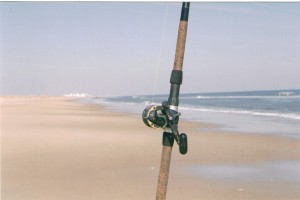
Fishing Rods – Typically when I hit the beach, I will normally have at least three rods with me, two heavers and one bait rod, but a lot of the time I will have more. It really all depends on how long I plan to be out fishing. If I can only fish for a few hours before dark, then I will only bring three, sometimes just the heavers. If we are going to make it a whole day, then I will bring 4 or 5 and load the pier/beach cart with more stuff then I probably need – but stuff I want to have “just in case.”
When I talk about my heavers, I am referring to the rods that are eleven to twelve feet in length. These are the rods that I use to hurl out 8 oz of lead and a big chunk of bait (“8 & bait”). A heaver is any rod that is 10 to 15 feet in length that will cast very far and cast a lot of weight. One of mine is 12 ft long and the other is 11 ½ ft long. Both rods are rated up to 10 oz, and that is probably the most important thing to keep in mind when buying a heaver: you need to be able to throw at least 8 oz, if not more. The length of the rod is equally as important. I believe the idea is that your rod is high enough to keep the line out of the shore break. If you constantly have waves crashing down on your line, it’s going to cause your rod tip to move and it will be tricky to detect bites. Obviously if a large fish or shark takes your bait, you will know – trust me, you will know!
Another thing I have noticed: sometimes after a storm there will be a lot of weeds or grass, or whatever you want to call it. When it’s thick, it’s a pain. However, a lot of the times the weeds are built up real thick in the first 5-10 feet of the water. I have seen the shore break look black from all the weeds that have built up. Having a long fishing rod will keep your line out of weeds.
A lot of people are astounded when they ask how much weight am I using and I tell them 8 oz. “What would you need that much weight for???,” they ask. Well here is my explanation: If I find a hole or a trough that I want to fish, I want my bait to stay in that spot and not move with the current. Add the wind and waves to that current and sometimes 8 oz won’t hold bottom either. I have been fishing before where 10 oz doesn’t bottom (not a fun day, to say the least!). The smallest weight I will throw with my heaver is 6 oz. Anything smaller in size I will not have enough weight to cast out.
The next important aspect of a heaver is what action and/or power it is rated at. The action refers to how much the rod tip bends when pressure (from casting or a fish) is applied. Action has 4 or 5 levels: slow, medium, fast and extra fast. The power refers to the rod’s strength, or the ability to lift a certain amount of weight from the tip. Typically the stiffer the rod (fast or extra fast action), the more weight you will be able to throw, and the less it will move in the surf. What I mean by moving in the surf is this: My 11 ½ footer is not as stiff as my 12 footer. So even on a calm day, the rod tip will move a little bit with the waves. This isn’t that big of a deal, just sometimes its hard to tell the difference between a wave and a light bite. For my heavers I prefer to have a stiffer rod, one with either fast or extra fast action.
Ok, on to the other fishing rods. First I want to talk about my bait rod. The one I use is a 9 footer; however anything from 7 to 10 feet will work, too. You ideally want a rod that will handle 4 to 6 ounces of lead, but a rod that is still flexible enough to see a bite from a small bait fish. A smaller rod can be used, but a lot of the times anything under 4 ounces will not hold bottom, and you really need to hold the rod while you’re fishing for bait. It’s always funny when you go to the beach and someone is fishing with a small fishing rod and their rig has already washed up 30 yards down from them. Don’t get me wrong, there is nothing wrong with using smaller rods; you just need to be aware of what your rig and bait is doing.
Another rod I normally carry with me to the beach is a “metal rod.” Normally I have a rod rigged up with some sort of spoon or Sting Silver type of lure. Typically I throw a 2 ounce Sting Silver, silver in color. The rod I use is a seven footer that is very stiff, but 7 to 9 feet will also work very well. I can throw up to 4 ounces with it and the reel I use is spooled with at least 200 yards of 15 – 20 pound braid. The reason I choose this rod for casting metals is three reasons: its stiff enough to handle larger lures, you have the back bone in case you hook into a good sized Bluefish or Spanish, and its light enough that you can work the lure a certain way if needed.
I normally keep my metal rod near my heavers in a sand spike ready to go. There have been several occasions where we’ve seen Spanish or Blues jumping in the surf, and typically they are moving pretty fast. Therefore you don’t want to waste any time tying on a lure and then chasing them down the beach. I can snatch the rod up and be casting a matter of seconds.
Sometimes in the fall, I will bring another rod with me: one for throwing smaller lures or jigs. During the fall, the Speckled Trout and Puppy Drum will make their annual migration south, and a lot of the times they can be caught throwing Mirror Lures, Jigs, or other types of jerk baits. This rod is typically not as stiff as my metal rod, because I’m throwing a lot lighter lure. Typically a 6-8 foot rod is ideal, as long as the action is medium to medium-heavy.
Fishing Reels – Now this is a topic that can go many different ways. Like I said in the beginning, this is merely my opinion and what I like to use. I’ll try to keep this part simple so this doesn’t drag on. On my heavers I use a conventional style reel, very similar to a bait caster, but with two major differences: it holds a lot more line and it does not have a level wind. There are many different manufacturers that make very good reels to use with your heaver; Daiwa is by far my favorite. The reason I like using a conventional style reel is because I can out-cast some of the spinning reels that I have. The reason for this is because (1) there is no level wind to slow the line down; and (2) the spool is spinning so the line more or less “falls” off the spool. This is more efficient than a spinning rod, where the line is actually pulling off the spool. On the reels I use, when you turn on “free spool,” the spool its self is actually “free floating.” Because of this feature, when you load up and cast, it spins for a long time.
All these little things help you out for distance. Obviously like a bait caster, you can’t just pick one up and throw cast “8 and bait” over 100 yards. It’s something that you really need to practice with. Every rod and reel loads and casts a little differently; it’s just a matter of practice. A good example: one of my heavers is 11ft 6in long. On a good day with the right wind, if I put everything into the cast and I don’t “blow it up” when casting with 6 ounces; I can cast almost 150 yards.
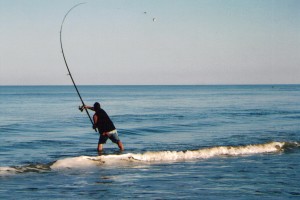
The rest of the rods I use for surf fishing have spinning reels. Whether it’s my bait rod or my lure rod, I prefer a spinning reel. I feel I can get the distance I need with lighter weight using a spinning reel. There are a bunch of different manufacturers out there that make many different types of reels. Find one that you like, that fits your reel and feels comfortable in your hands. This can also apply to your heaver. If you have a rod already, take it with you when looking at reels. If you find one that you like, see if they will let you put it on your rod so that you can see how it feels. The worst thing is to find after casting over and over again is that your rod doesn’t feel right or is uncomfortable or too heavy, too bulky, etc.
Another important thing to keep in mind when purchasing a reel is how much line it holds. On my bait rods and casting rods I want at least 100 yards of whatever weight I am using. On my heavers I prefer to have at least 275-300 yards (if not more). I have had several people ask me why I would want that much line on my heavers. Well a great example is the citation Cobia I caught this year. When he took the bait he ran, and ran hard. I had casted my bait out at least 80-100 yards on that fateful cast, and when I hooked the monster, he ran another 100 yards easily on his initial run. I have also hooked into large sharks and rays that have tried to take me to Europe. My point is you want enough line to accommodate any long run that you may encounter.
Fishing Line – One of the biggest misconceptions about surf fishing is that you need big line to catch big fish. That is not true. The 75lb Cobia I caught off the beach was caught on 20lb main line with a 50lb shock leader. I have friends in Maryland that have caught 8 and 9 foot sharks off the beach using 17 and 20lb line!
My heavers are spooled with 20lb and 15lb test mono. There are many different manufacturers that make really good line for casting. Some of them are better than others, but a lot of it is personal preference. I prefer to use either Berkley Big Game or Offshore Angler’s Tight Line, but like I said, that’s just my preference. For my shock leader, if my main line is 15lb test, I will use 40lb for my shock leader. if my main line is 20lb, I will use 50lb for my shock leader. The shock leader does several things for you. First, it allows you to put everything you’ve got into casting 8 ounces plus bait without snapping the line. Secondly, if you catch a large fish, after you get a few wraps of shock leader on your spool, you can sometimes maneuver/horse it a little bit more. One thing to keep in mind is the diameter of your shock leader. I have shopped around and found a small diameter 50lb test line. If the shock leader material is too thick, you will have a big knot that could possibly affect your cast or get hung up on one of the eyes of the rod. As far as the knot goes, I typically use the Albright special to join my main line to my shock leader. However, there are many other knots that are good and strong that can be used as well.
The shock leader length is also personal preference. I prefer at least 20 feet, but some like more for drum and striper fishing. The idea is that when you’re ready to cast, you want the shock leader to run from your bait all the way down your rod and then have several wraps on your reel. You don’t want to put too much because the difference in size between the diameters of your main line and shock leaders will cause the spool to spin differently when casting. In other words, if you find that you are constantly blowing up your heaver when you cast, try a shorter/thinner shock leader.
Some people have asked me about whether or not I use braid on my heavers. Although I know a few people that do, I never have and don’t plan on it. There are advantages and disadvantages of using mono versus braid. For example, mono stretches, while braid does not. I think braid moves more in the water then mono does. With braid you can go up in pound test and be at the same diameter of mono. I think the biggest disadvantage with braid is, if you blow up the reel using braid, and a loop grabs your thumb, it could potentially do some damage. Additionally, blow ups/back lashes are harder to get un-done with braid.
The other rods that I use are all spooled with braid. I like braid on these rods for several reasons. The main one is that my brand of choice for 20lb test braid has the same diameter as 6 lb mono. That means I can fill my reel with heavier braid and still get the amount of line on there that I need. This allows me to fish a smaller, lighter reel. For example, my bait rod reel is more or less a fresh water reel. It will normally hold 300 yards of 10lb mono. Therefore if I fill it with 30lb braid, which has the same diameter as the 8lb mono, I can get just as much line on the spool but the braid is much stronger.
Even though I mentioned before that braid tends to move more in the surf, if you hook a large skate or ray on your bait rod, you want to make sure your line can handle it. I have caught some giant clear nose skates on my bait rod before and I like having the comfort of knowing I will be able to drag the skate in without breaking my line and losing my rig. I like having braid on my metal rod as well, however I normally use 20lb because I know the lighter the line, the farther I will be able to cast.
Most of the time I will not use any sort of mono or fluorocarbon leader on my metal or lure rods, unless the surf is extremely clear. It doesn’t happen often, but there have been a few days this year where the water was super clear up to about 4 feet. I was standing in water up to my waist one day and could clearly see my toes. In fact that day I was standing there throwing a sting silver and looked down and watched a 2ft Butterfly Ray swim past my feet. Kind of exciting and scary all at the same moment!
I hope this write up has answered many of the questions you may have had.

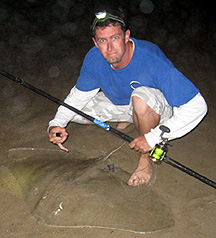
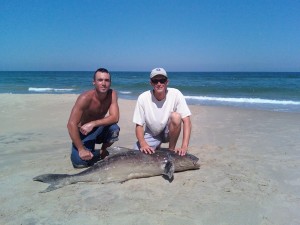

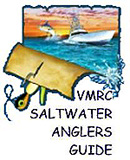


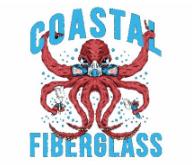





 Views Last 7 days : 1913
Views Last 7 days : 1913 Views Last 30 days : 9021
Views Last 30 days : 9021